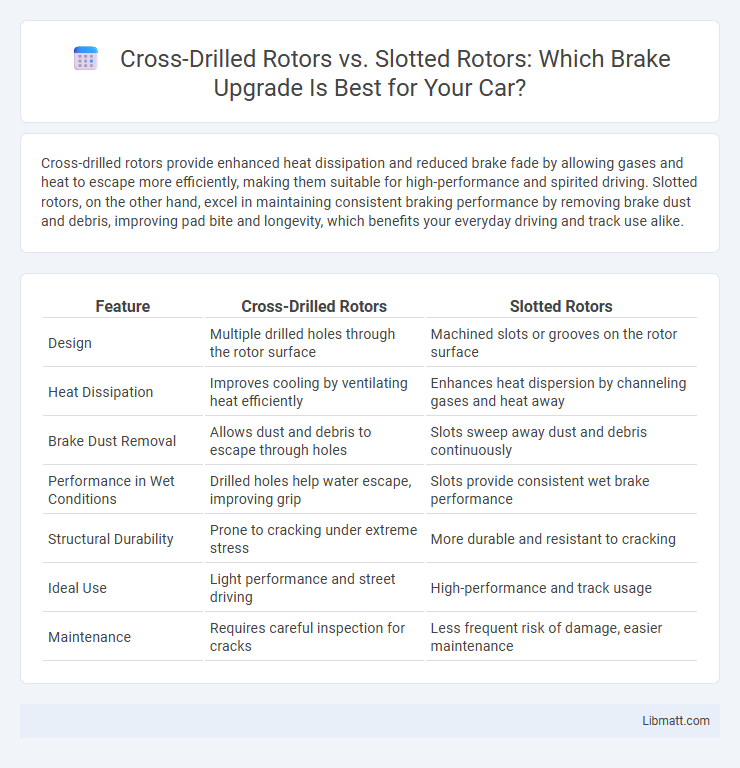Cross-drilled rotors provide enhanced heat dissipation and reduced brake fade by allowing gases and heat to escape more efficiently, making them suitable for high-performance and spirited driving. Slotted rotors, on the other hand, excel in maintaining consistent braking performance by removing brake dust and debris, improving pad bite and longevity, which benefits your everyday driving and track use alike.
Table of Comparison
| Feature | Cross-Drilled Rotors | Slotted Rotors |
|---|---|---|
| Design | Multiple drilled holes through the rotor surface | Machined slots or grooves on the rotor surface |
| Heat Dissipation | Improves cooling by ventilating heat efficiently | Enhances heat dispersion by channeling gases and heat away |
| Brake Dust Removal | Allows dust and debris to escape through holes | Slots sweep away dust and debris continuously |
| Performance in Wet Conditions | Drilled holes help water escape, improving grip | Slots provide consistent wet brake performance |
| Structural Durability | Prone to cracking under extreme stress | More durable and resistant to cracking |
| Ideal Use | Light performance and street driving | High-performance and track usage |
| Maintenance | Requires careful inspection for cracks | Less frequent risk of damage, easier maintenance |
Introduction to Brake Rotor Types
Cross-drilled rotors feature holes drilled through the surface to enhance heat dissipation and improve wet performance, making them suitable for high-performance driving and track use. Slotted rotors have grooves machined into the surface that help remove brake dust, gas, and moisture, ensuring consistent braking power and reducing pad glazing in aggressive driving conditions. Your choice between these brake rotor types should balance performance needs with durability, as cross-drilled rotors may be more prone to cracking under extreme stress compared to slotted rotors.
How Cross-Drilled Rotors Work
Cross-drilled rotors feature precision-drilled holes that allow heat and gases to escape, enhancing cooling and reducing brake fade during intense braking sessions. This design improves wet weather performance by enabling water to dissipate quickly from the rotor surface, maintaining effective stopping power. You benefit from increased brake responsiveness and consistency, especially in high-performance or racing applications.
How Slotted Rotors Work
Slotted rotors improve braking performance by channeling gases, dust, and water away from the rotor surface, maintaining consistent contact between the brake pad and rotor. The slots enhance heat dissipation and help prevent brake fade during aggressive driving or heavy braking conditions. This design is particularly effective in high-performance and off-road vehicles where intense braking demands occur.
Heat Dissipation: Cross-Drilled vs Slotted
Cross-drilled rotors excel in heat dissipation by providing multiple holes that allow hot gases and heat to escape quickly, reducing brake fade during intense braking. Slotted rotors enhance heat dissipation by channeling away heat and debris through surface grooves that maintain a clean brake pad surface, improving consistent braking performance. Both designs improve cooling compared to solid rotors, but slotted rotors generally offer longer-lasting efficiency under high-temperature conditions due to their superior debris management.
Brake Performance and Stopping Power
Cross-drilled rotors excel in heat dissipation and gas evacuation, enhancing brake performance under high-stress conditions, which improves stopping power by reducing brake fade. Slotted rotors provide superior pad bite and debris removal, maintaining consistent friction and enhancing stopping power, especially in wet or dirty environments. Both designs optimize braking efficiency, but cross-drilled rotors favor high-performance heat management, while slotted rotors focus on sustained braking reliability and consistent stopping power.
Durability and Longevity Comparison
Cross-drilled rotors offer enhanced heat dissipation but may be prone to cracking under extreme stress, impacting durability and longevity. Slotted rotors provide improved performance by continuously clearing debris and gases, which helps maintain braking efficiency and extends rotor lifespan. Choosing between them depends on your driving conditions, with slotted rotors generally preferred for durability in harsh environments.
Suitability for Daily Driving
Cross-drilled rotors offer improved heat dissipation and gas expulsion, making them suitable for drivers who encounter occasional heavy braking in daily driving conditions. Slotted rotors excel in continuous, consistent performance by efficiently removing brake dust and maintaining pad bite, ideal for daily commuters facing stop-and-go traffic. Both rotor types enhance braking efficiency, but slotted rotors generally provide more durable performance with less risk of cracking under everyday road use.
Performance in Wet and Dry Conditions
Cross-drilled rotors excel in wet conditions by allowing water to escape quickly, reducing brake fade and maintaining consistent stopping power. Slotted rotors enhance performance in dry conditions by providing better heat dissipation and debris removal, which helps sustain maximum friction and brake responsiveness. Choosing the right rotor ensures your braking system performs optimally in both wet and dry environments.
Maintenance and Cost Considerations
Cross-drilled rotors often require more frequent maintenance due to their susceptibility to surface cracking under high-stress conditions, which can lead to higher replacement costs. Slotted rotors generally offer improved braking performance with less risk of cracking, resulting in lower maintenance frequency and potentially reduced long-term expenses. The initial cost of slotted rotors may be higher, but their durability often balances overall maintenance budgets compared to cross-drilled designs.
Choosing the Right Rotor Type for Your Needs
Cross-drilled rotors offer enhanced heat dissipation and improved wet-weather braking, making them suitable for high-performance vehicles driven in varied conditions. Slotted rotors excel at removing brake dust and gas buildup, providing consistent braking power ideal for heavy-duty or track use. Understanding your driving style and performance needs helps you choose the right rotor type to optimize Your vehicle's braking efficiency and safety.
Cross-drilled rotors vs Slotted rotors Infographic

 libmatt.com
libmatt.com